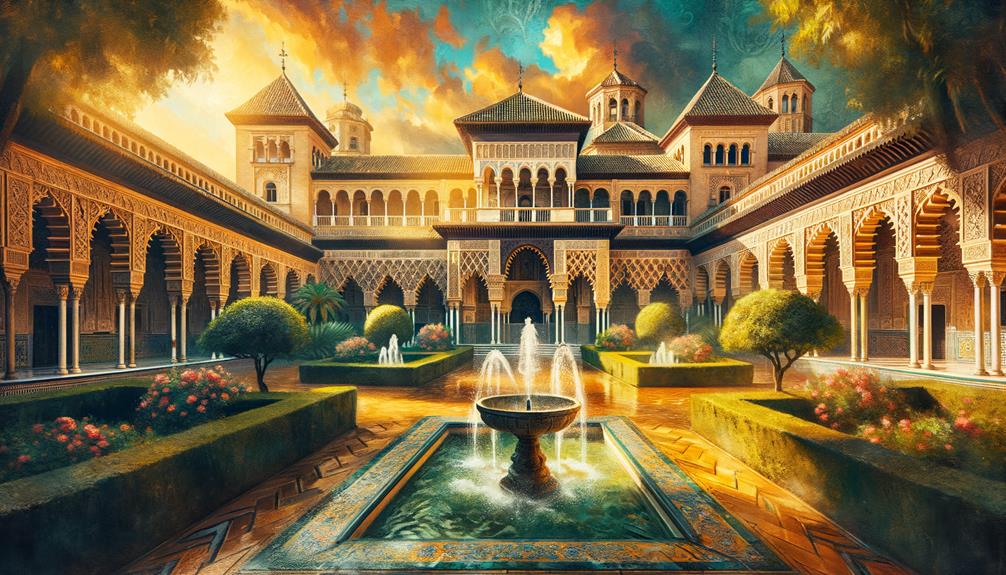Wandering through the Seville Alcazar, I felt like I'd entered a timeless realm where history whispers secrets. The intricate Mudéjar designs evoke the grandeur of Moorish rule, while Renaissance and Baroque touches add a layer of European sophistication. Every corner, from the lush gardens to the opulent royal chambers, seemed to hold stories waiting to be uncovered. As I explored the palace, I couldn't help but feel the weight of its historical significance. One particular area caught my attention more than any other, and it's something you shouldn't miss.
Historical Significance
The Seville Alcazar, a former Moorish fort transformed into a palace by King Peter of Castile, stands as a testament to Spain's complex history and cultural blending. As I walked through its storied halls, I felt the weight of centuries of Spanish history. This site is more than just a beautiful palace; it's a living demonstration of the Royal Alcazar of Seville's historical significance.
Peter of Castile's vision merged Christian and Moorish elements, creating a unique Mudéjar architecture. It's like stepping into a timeline where Islamic craftsmanship meets Gothic grandeur. The Alcazar's architectural features tell stories of conquest and coexistence, a blend that mirrors the complex narrative of Seville's history.
Designated a UNESCO World Heritage site in 1987, the Alcazar showcases not only structural beauty but also embodies the resilience and fusion of diverse influences. The intricate designs and diverse styles reflect a period when cultures clashed, yet somehow harmonized. As I stood there, I felt a profound connection to the past, a sense of wonder at how different worlds came together to create something timeless. The Alcazar is more than just history; it's an experience that can be felt.
Architectural Highlights
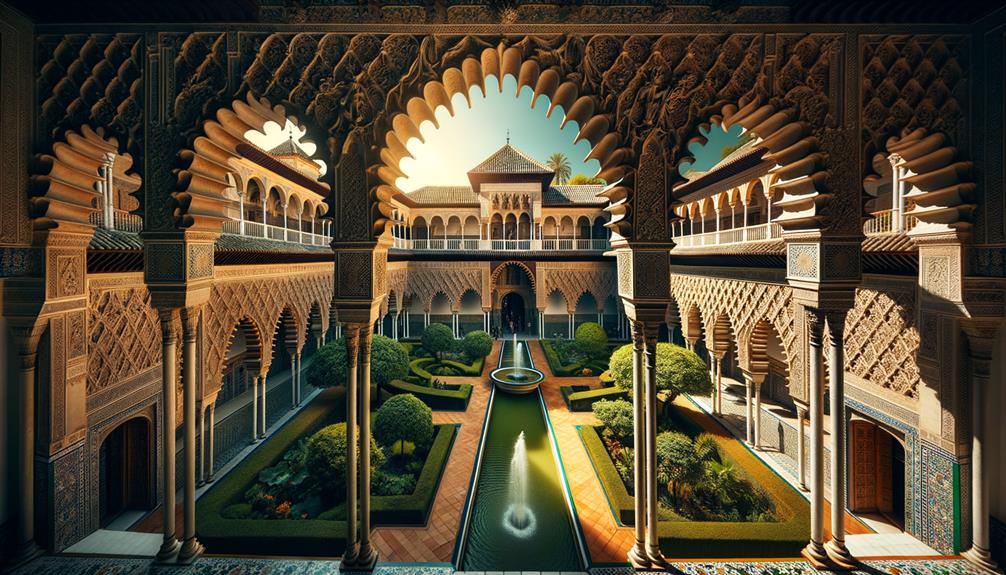
As I strolled through the Alcazar, I was struck by the intricate Mudejar plasterwork and vibrant tiles in the Patio de las Doncellas. The palace's blend of Renaissance and Baroque elements added depth and artistic flair. Every corner of the palace seemed to hold a story, inviting me to linger and absorb its timeless beauty.
Mudéjar Style Masterpieces
Walking through the Alcázar's grand halls, I'm immediately struck by the mesmerizing interplay of geometric patterns and stylized calligraphy that define its Mudéjar style masterpieces. This unique architectural style blends Islamic and Christian influences, where the Moorish emphasis on intricate designs meets Gothic and Renaissance elements. Each room is a testament to cultural fusion, where skilled craftsmanship brings walls, ceilings, and arches to life with vibrant colors and textures.
The geometric patterns are not just decorative; they're a visual feast, echoing the mathematical precision and artistic elegance of Islamic art. Every glance reveals something new: a hidden motif, a delicate curve, a burst of color. The rich plasterwork and arabesques envelop me in a world where every detail tells a part of Seville's historical narrative.
The Mudéjar ceilings stand out, their complex woodwork and gilded details reflecting both Moorish and Christian artistry. It's as if time stands still, allowing me to fully immerse in the architectural grandeur. Here, the Alcázar's Mudéjar style masterpieces offer a profound glimpse into the layered history and artistic evolution of Seville.
Renaissance and Baroque Elements
Upon entering the Alcázar's Renaissance and Baroque sections, I'm struck by the intricate plasterwork and elaborate decorations that reveal Spain's rich cultural heritage. The geometric designs, meticulously crafted, reflect the Renaissance era's pursuit of harmony and balance. I marvel at the ornate decorations that adorn the walls, each detail a testament to the Baroque period's flair for drama.
Walking through these halls, I notice how seamlessly the Renaissance and Baroque elements blend with the Alcázar's Mudéjar architecture. The fusion of Islamic and Christian influences creates a visually stunning tapestry, each architectural feature contributing to a narrative of cultural history. The intricate plasterwork, with its complex patterns and geometric designs, showcases the Renaissance's artistic achievements, while the Baroque's lavish details add a layer of luxury.
The Alcázar's ability to harmonize such diverse styles makes it a unique experience. Standing here, I feel a deep connection to the past, as if the walls themselves whisper tales of a bygone era. It's a reminder of the importance of exploring and appreciating the rich tapestries of human creativity and cultural expression.
Must-See Areas
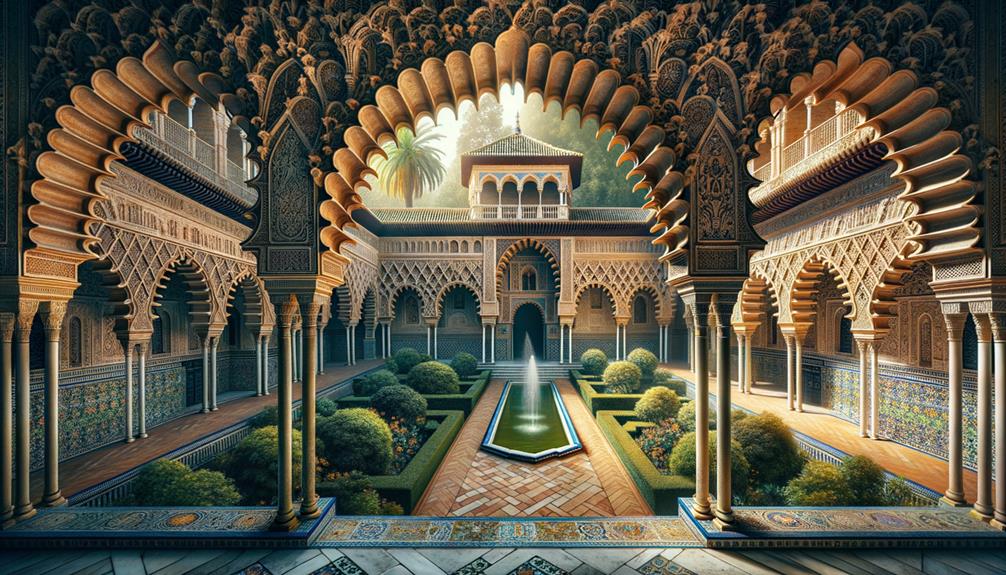
Stepping through the Puerta del León, you're immediately immersed in the rich history of Seville's Alcázar, where every corner reveals a new facet of its storied past. The Patio de las Doncellas, with its intricate Mudejar style, captivates you with its vibrant patterns and ornate details. As you wander through the Alcázar Gardens, the serene ambiance created by nearly 200 plant species feels like a tranquil escape from the bustling city.
The Alcázar, a UNESCO World Heritage Site, offers an incredible journey through time. On a guided tour, you'll uncover the historical events and dynasties that have shaped this majestic palace. The royal chambers exude luxury, and the courtyards reflect centuries of cultural influence. It's fascinating to learn about the Alcázar's significance as a Game of Thrones filming location, adding a touch of modern mystique to its ancient allure.
Must-see areas include:
| Area | Highlight |
|---|---|
| Puerta del León | Imposing entrance, diverse architecture |
| Patio de las Doncellas | Exquisite Mudejar style |
| Alcázar Gardens | Tranquil oasis, 200 plant species |
| Royal Chambers | Opulent decor, historical significance |
| Courtyards | Cultural and architectural diversity |
Every step in the Alcázar is a journey through history, a celebration of discovery and exploration.
Ticket Information
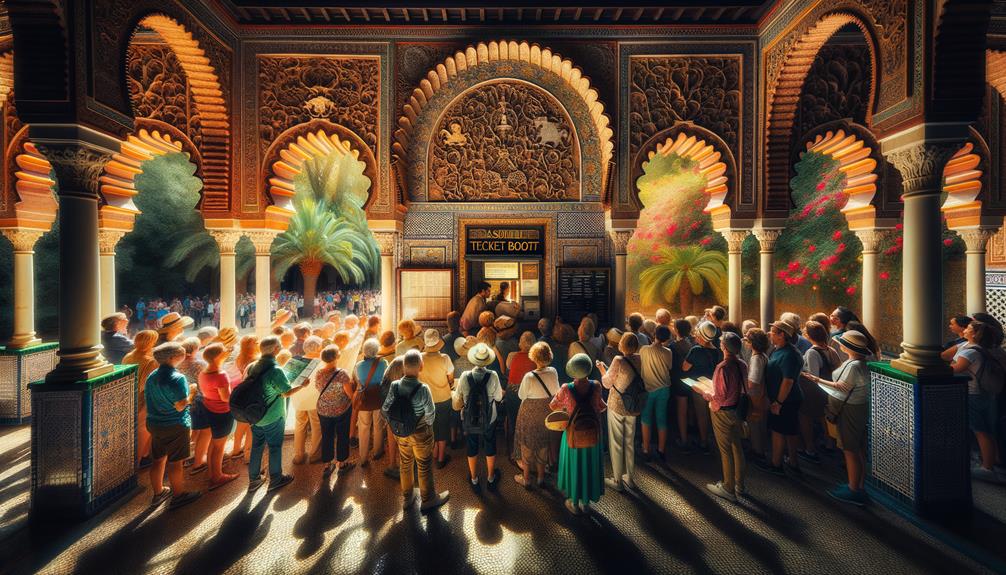
As I gazed upon the Alcázar's breathtaking beauty and historical significance, I realized that securing tickets would be the next step in ensuring a seamless visit. The Alcazar of Seville ticket costs €14.50 for general admission, but considering the palace's capacity of only 750 people, long waiting lines are inevitable during peak seasons. To avoid these lines and make the most of my time, I booked skip-the-line tickets online in advance. This meant I could immerse myself in the grand courtyards and intricate mosaics, rather than standing in a queue.
To make the most of my experience, I considered a few options:
- Combo guided tours, which offer a deeper understanding of the palace's history and architecture.
- Royal Apartments access, which requires an additional ticket but is worth the extra cost.
- Booking in advance, which is essential for securing a spot and avoiding disappointment.
- Skip-the-line tickets, which save time and allow for a more relaxed exploration.
- The palace's limited capacity, which emphasizes the need for early planning.
With these choices, my visit to the Alcázar promised to be both efficient and richly rewarding.
Best Visiting Times
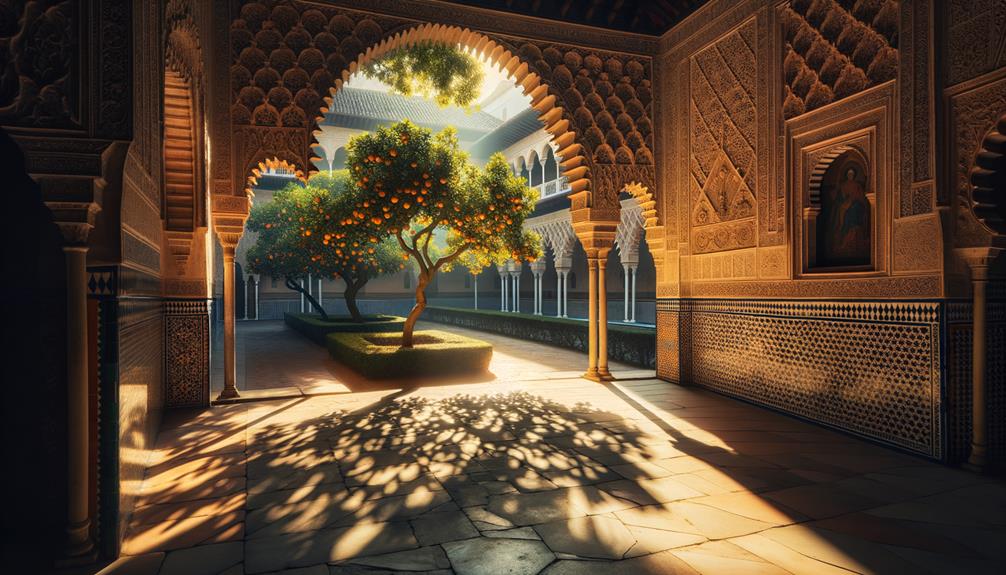
When planning my visit to the Alcázar, I quickly learned that arriving early in the morning or late in the afternoon on weekdays would allow me to explore the palace's splendor without battling the crowds. The best time to visit is during the serene hours when the sunlight casts a delicate glow on the intricate Spanish architecture, making the Royal Alcázar feel like a living tapestry of history.
Spring and fall emerged as my preferred seasons for this adventure. The weather in Seville during these months is perfect – neither too hot nor too cold, ideal for leisurely strolls through the lush Gardens. The blooms in spring and the rich colors of fall enhance the Alcázar's timeless beauty, making every corner a picturesque frame.
Winter, though quieter, offers its own charm. Visiting the Royal Alcázar during this tranquil period means fewer tourists, allowing for a more intimate connection with the historical essence of the place. I could wander freely, absorbing the whispers of the past echoed in every tile and arch.
In every season, the Royal Alcázar in Seville offers an unparalleled tour of Royal elegance and Spanish heritage, making each visit a unique exploration.
Getting There
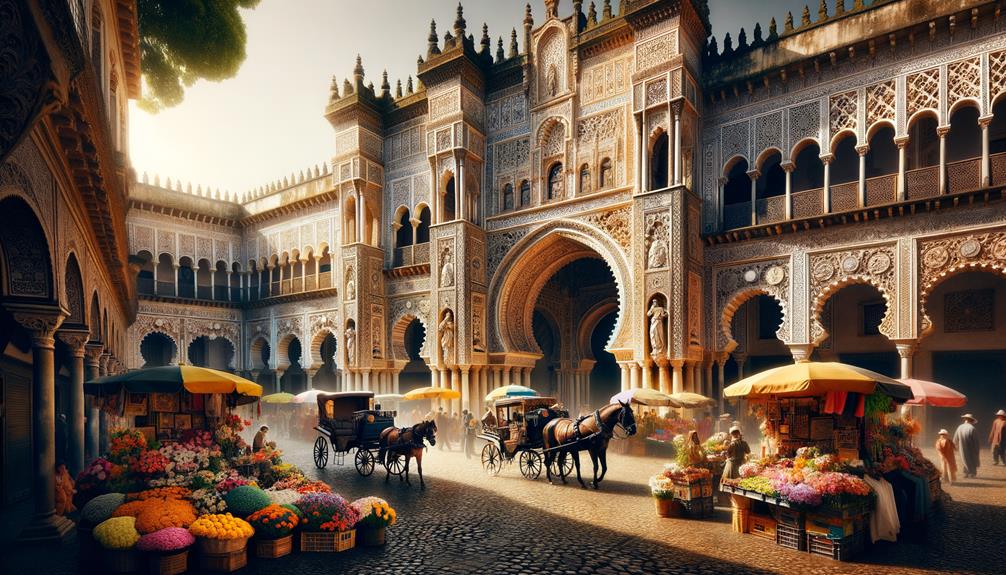
Finding the Alcazar was surprisingly easy, thanks to its central location behind the cathedral. I had a few convenient options to get there: bus C5, Metro Line 1, or Tram T1. If you're driving, the A-4 and A-92 highways will take you straight to Seville, with parking available at Josà Laguillo.
Public Transportation Options
Wandering the vibrant streets of Seville, I found the most efficient way to reach the majestic Royal Alcazar was by using public transportation. Each mode offers a unique glimpse into the city's daily rhythm, making the journey itself a memorable part of the exploration.
Using public transportation options, I experienced the city's pulse:
- Bus C5: This route winds through narrow streets, showcasing Seville's charming architecture.
- Metro Line 1: A swift and modern way to travel, offering a contrast to the historic surroundings.
- Tram T1: This tram glides gracefully, providing panoramic views of bustling plazas and hidden alleys.
- Car access via A-4 and A-92 highways: Smooth drives connect the broader Andalusian landscape to the city's heart.
- Central location and accessibility features: The Alcazar is welcoming to everyone, with features like ramps and detailed audio guides.
As I approached the Alcazar, the seamless integration of old and new became apparent. The central location means that whether you're arriving by bus, metro, tram, or car, the journey is enchanting. The accessibility features highlight Seville's commitment to inclusivity, ensuring everyone can appreciate its historical splendor.
Parking Facilities Nearby
Exploring Seville's streets, I found convenient parking facilities near the Alcazar, including the underground Parking Entrada Peatonal – José Laguillo and Interparking Cano y Cueto. These underground car parks offer a hassle-free solution for drivers. With Seville's central location, getting to the Alcazar from these spots is easy.
Driving through Seville's historical streets, I appreciated the proximity to major highways like the A-4 and A-92, which made reaching the Alcazar straightforward. Once parked, I was free to explore the city's vibrant culture and stunning architecture on foot.
If you prefer not to drive, public transportation is a reliable option. The Bus C5, Metro Line 1, and Tram T1 routes connect travelers to the heart of Seville, offering a unique perspective of the city as you approach the Alcazar.
Walking from the parking facilities or public transport stops, I felt a sense of excitement and anticipation as I neared one of Seville's most iconic landmarks. The ease of access truly made the experience more enjoyable.

